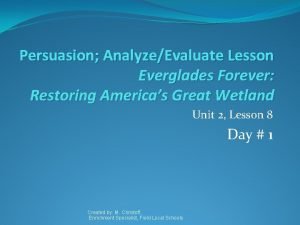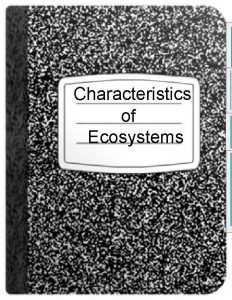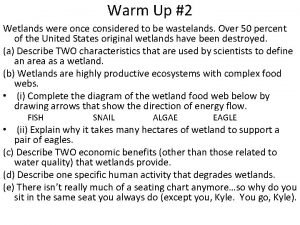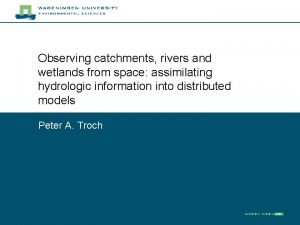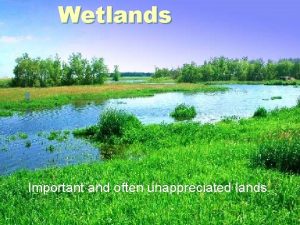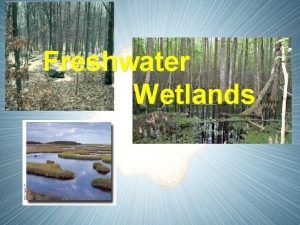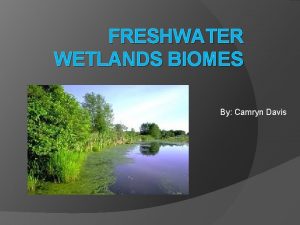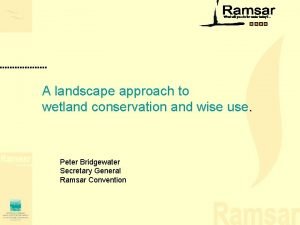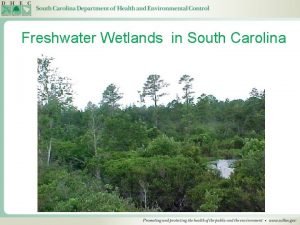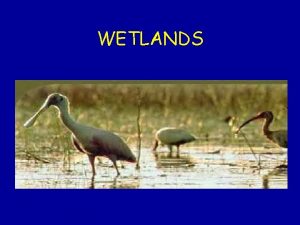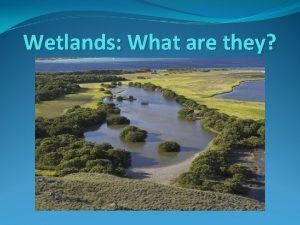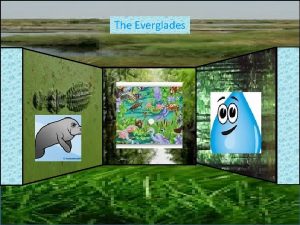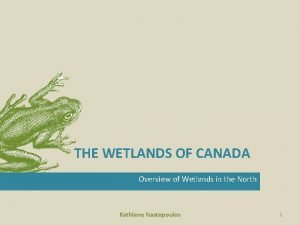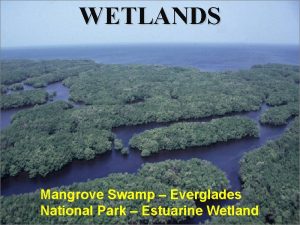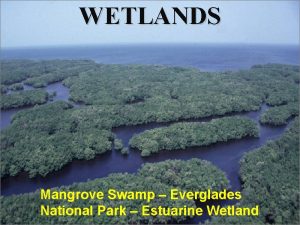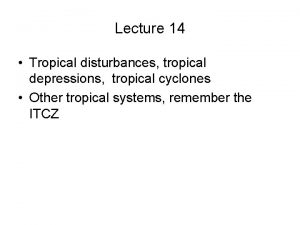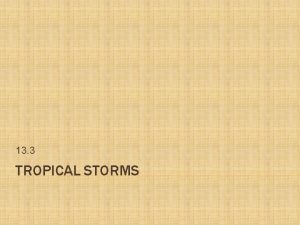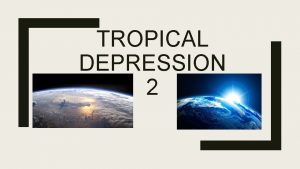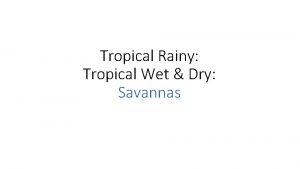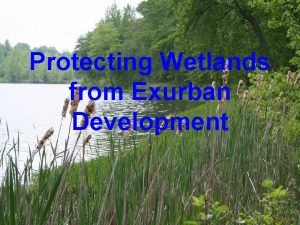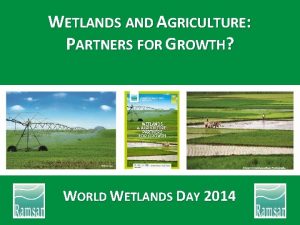The Everglades Overview The everglades are tropical wetlands


















- Slides: 18

The Everglades

Overview: The everglades are tropical wetlands located in the southern United States in the state of Florida. The everglades is part of a protected area known as the Everglades National Park.

Formation: The everglades began their formation over 21, 000 years ago during the last glacial maximum. During this period continental ice shelves retreated and sea levels rose which led to the Florida water table rising. The majority of the land was covered in limestone which became saturated and slowly eroded eating away at the surface which helped create springs and sinkholes. Then as the surface broke apart the rain water, ground water, and ocean water all came together to create the region as it is today.

History: The first written records of the area are from a Spanish map from the 16 th century. The area was originally named the “Laguna del Espiritu Santo” which translates to the Lake of the Holy Spirit. The name “everglades” was first used in 1773 by British surveyor John Gerard de Brahm.

Water Source: The majority of the water that is within the everglades is fed by the Kissimmee, Caloosahatchee, Myakka, and Peace rivers. These rivers are all located in central Florida and their waters may take months to reach their final destination in the Florida Bay. Along with these water sources the everglade wetland system is also sustained by evapotranspiration which is the sum of evaporation and plant transpiration from the earths land surface to the atmosphere.

Climate: The southern Florida climate falls between the subtropical and tropical climate region. From the months of November – April the “dry season” takes place and the wet season is from May – October. The average annual rainfall is 62 inches with temperatures narrowly ranging from 65 -82 degrees Fahrenheit throughout the year.

Fire: Throughout the year there are fires throughout the everglades which are very helpful in maintaining their eco-system. The fires only destroy the tops of plants which helps with releasing nutrients into the water and roots without killing the plant life. The fires also prevent larger trees and plants from growing which help preserve the marshes.

Eco-Systems Islands Pineland Cypress Mangrove Forest Florida Bay

Islands: Within the everglades there are small islands of trees growing on raised up parts of land. These islands are called tropical hardwood hammocks. The trees that make up these islands are usually southern live oak, gumbo limbo, royal palm, and bustic. The islands can be just a few feet to 10 acres in size. The islands are protected by sharp saw palmettos which make it difficult for humans to access the islands.

Pineland: The driest eco-system in the Everglades is pineland. This area can be found in the highest points of the everglades. The most dominant feature is the thick Florida slash pine trees. Due to a high amount of fires in the area these trees have adapted to resist high temperatures of heat and therefore dominate the forest floor with few other plants able to survive.

Cypress: There are many Cypress swamps found throughout the everglades but the largest can be found in Collier County which also contains the Big Cypress Swamp. These swamps are filled with conifer trees that have adapted to grow in flooded areas. These trees include red maple, swamp bay, and pop ash.

Mangrove: As the waters from Lake Okeechobee and the Big Cypress come close to the ocean there an abundance of mangrove trees. Within this area the fresh water meets salt water to form brackish water. This area contains the largest continuous system of mangrove trees in the world. The area is almost 200, 000 acres in size and contains the Ten Thousand Islands which is almost completely mangrove forests. The three species of mangrove trees are the red, black, and white mangrove trees.

Florida Bay: Within the Florida Bay there are over 800 square miles protected by the Everglades National Park. Within this area there are many mangrove forests along with turtle grass and large formations of algae.


Amphibians and Reptiles: There are over a dozen different species of amphibians in the Everglades. These species include the southern toad, little grass frog, peninsula newt, and the invasive species greenhouse frog. There are over 50 different species of reptiles in the park. These species include the American alligator, the endangered eastern indigo snake, American crocodile, and the invasive brown anole.

Fish and Birds: There are over 300 different species of fish in the waters of the everglades. These fish include fresh and sea water fish. Fishing is a popular activity within the everglades but a fishing license is required. One of the more unique fish is the Gulf toadfish. Over 350 different species of bird have been seen in the everglades. One popular group of birds is the wading birds. These birds include the wood stork, roseate spoonbill, and great egret.

Mammals: There are over 40 species of mammal that live in the everglades. The only marsupial mammal in the everglades is the opossum. Other species include the endangered Florida panther, the grey fox, striped skunk, river otter, and the invasive red fox.

KLS Reading 2015 @TPT
 Antigentest åre
Antigentest åre Everglades landforms
Everglades landforms Everglades forever book
Everglades forever book Everglades snail kite
Everglades snail kite In what hemisphere does the prime meridian place georgia
In what hemisphere does the prime meridian place georgia Bill nye rivers and streams
Bill nye rivers and streams Why are wetlands important for biodiversity
Why are wetlands important for biodiversity Wetlands were once considered to be wastelands
Wetlands were once considered to be wastelands Wetlands
Wetlands Why are wetlands important
Why are wetlands important Wetland ecosystem definition
Wetland ecosystem definition Which statement describes the concept of number sense?
Which statement describes the concept of number sense? Climate of freshwater wetlands
Climate of freshwater wetlands Conservation of wetlands
Conservation of wetlands Các châu lục và đại dương trên thế giới
Các châu lục và đại dương trên thế giới Bổ thể
Bổ thể Từ ngữ thể hiện lòng nhân hậu
Từ ngữ thể hiện lòng nhân hậu Diễn thế sinh thái là
Diễn thế sinh thái là Tư thế ngồi viết
Tư thế ngồi viết


